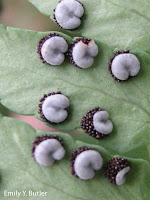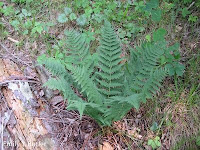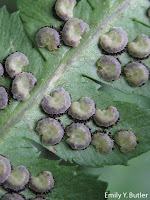I'm settling into our very comfortable temporary home in Alexandria, Virginia, from whence I'll be commuting to the Smithsonian starting tomorrow. We're only about a mile from the Pentagon - exciting! I wonder if they ever think about ferns in there...
Pictured above is Goldie's Fern, Dryopteris goldiana, photographed in the UW-Madison Arboretum. We saw quite a lot of it on the walk I led the other day; it loves moist, rich, shady forest understories, and so is very happy in the Arb's Gallistel Woods. Unfortunately so are the mosquitos, but that's another story.
We were wondering about the specific epithet of this fern, goldiana, and where it and the common name came from. Kathy Miner, who is in charge of Educational Programs at the Arboretum and facilitated the scheduling of the fern walk, did some digging and discovered that it was named for John Goldie, a 19th-century Scottish botanist who came to North America several times to conduct research and field trips. He made his first visit in 1817, when he was 22, and in 1819 he walked from Montreal to Philadelphia and back. It was during this second trip that he collected a specimen of what would come to be known as Goldia's Fern, D. goldiana. He also kept a diary during this journey, which was later published by his granddaughter as "Diary of a Journey Through Upper Canada and Some of the New England States, 1819." Kathy discovered that this slim volume is still available through some rare and antique book dealers, so I'm going to try and acquire a copy! Goldie was a protege of the great botanist Sir William J. Hooker (father of Sir Joseph Dalton Hooker, Darwin's botanical ally and perhaps the first person to hear his ideas on natural selection). He was also very interested in the Niagara region, as were many other influential botanists and geologists of the time, including Charles Lyell.
The Missouri Botanical Garden has an interesting reprint online about John Goldie's North American travels, geology, and the state of evolutionary theory during this part of the 1800s, and there is a short biography of him available from the Peel Teaching Garden's website.


























